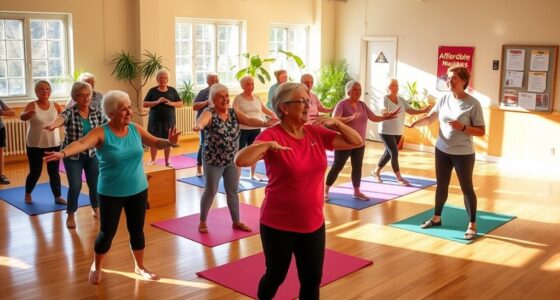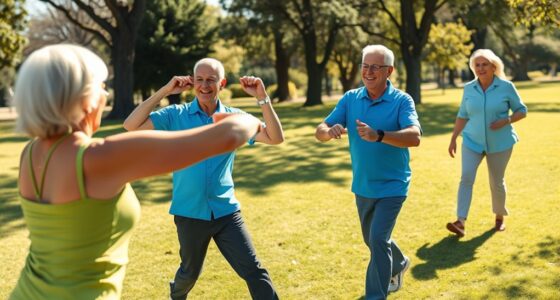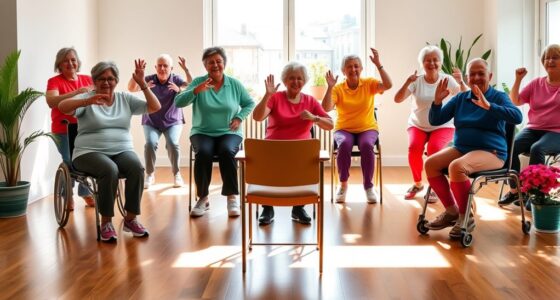Strength training is essential for seniors to boost strength, maintain independence, and improve health. Start with bodyweight exercises like chair squats and wall pushups to build a solid foundation. Once you’re comfortable, incorporate light weights for added intensity, or use resistance bands for safe, joint-friendly workouts. Don’t forget core stability exercises like planks to enhance balance. With progressive plans and safety tips, you can master these routines today. Discover more ways to stay fit and active.
Key Takeaways
- Start with bodyweight exercises like chair squats and wall pushups to build foundational strength and improve balance.
- Incorporate light weights (2-3 pounds) to enhance muscle strength and flexibility while managing chronic conditions.
- Use resistance bands for low-impact exercises that target various muscle groups without straining joints.
- Include core stability exercises like planks to improve balance, posture, and reduce fall risk.
- Engage in community fitness programs for motivation, social interaction, and to enhance overall well-being.
The Importance of Strength Training for Seniors

When you consider the aging process, strength training stands out as an essential component for maintaining your health and independence. It helps combat bone loss and strengthens bones, reducing the risk of osteoporosis. By improving your muscle mass and strength, you enhance your overall functional abilities, making daily tasks like bathing or grocery shopping easier. Regular strength training also boosts cardiovascular health and supports cognitive function, contributing to better mental well-being. Additionally, it enhances balance and stability, lowering your risk of falls. Most importantly, it can help you maintain your mobility and decrease frailty, ensuring you stay active and engaged in life. Embracing strength training now can greatly improve your quality of life as you age, as it aids in overall physical fitness and promotes a healthier lifestyle. Furthermore, engaging in regular physical activity can reduce feelings of isolation, enhancing both your physical and mental health as you connect with others. Incorporating effective relaxation techniques into your routine can further support your overall well-being and recovery. To maximize your strength training benefits, consider utilizing proper techniques to prevent injuries and ensure effective workouts. Strength training not only improves physical capabilities but also fosters resilience in creativity, which can be valuable in overcoming challenges in daily life. Additionally, studies show that pet therapy can enhance emotional well-being, making it a beneficial complement to your strength training routine.
Essential Bodyweight Exercises for Beginners

Bodyweight exercises are an excellent starting point for beginners looking to build strength and improve fitness. You can enhance lower body strength and balance with chair squats by sitting and standing up from a sturdy chair. Modify traditional pushups using wall pushups to accommodate your upper body strength. For hip and thigh muscle strength, try leg raises while seated, and improve mobility with seated marching. Additionally, these exercises strengthen lower-body muscles and are perfect for seniors of all fitness levels. Incorporating bodyweight exercises into your routine can greatly benefit overall health and mobility. Engaging in regular physical activity is vital for promoting emotional and psychological growth as it helps enhance overall well-being. Furthermore, focusing on market research can help identify the most effective exercises tailored to individual needs. Including low carb high protein breakfast ideas can provide the necessary energy to fuel your workouts. Research indicates that regular exercise can significantly improve mental clarity and overall cognitive function.
Wall sits are great for building lower body endurance. These exercises are accessible, cost-effective, and help prevent injuries as you focus on your body weight. Always engage your core, control your movements, and consult a healthcare provider before starting. Aim for consistency, gradually increasing intensity for the best results.
Incorporating Light Weights Into Your Routine
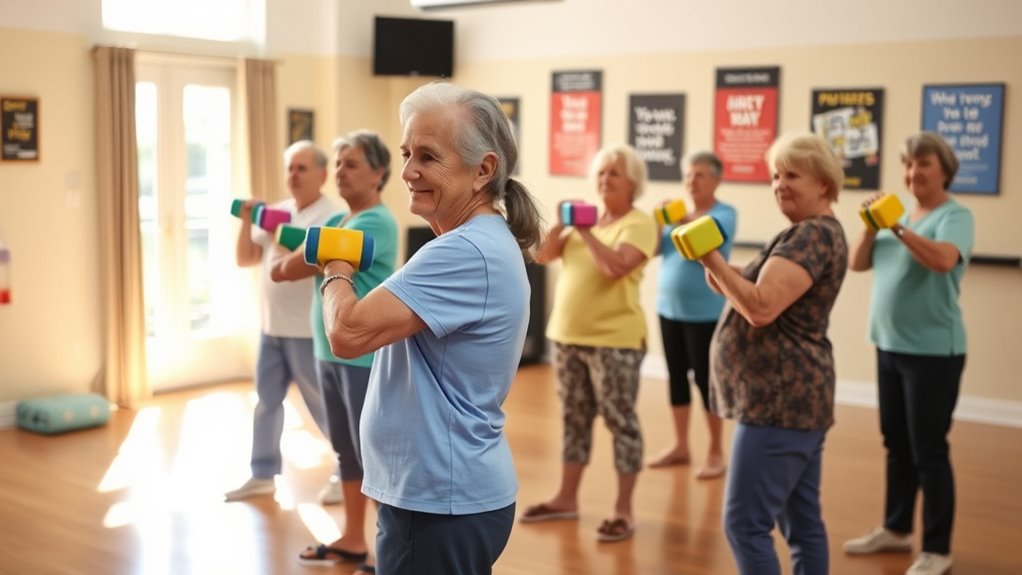
Incorporating light weights into your routine can greatly enhance your strength training experience, especially as you age. Using weights of 2-3 pounds can improve balance, reduce fall risk, and boost mobility by strengthening key muscles. Light weights are also beneficial for managing chronic conditions like arthritis and osteoporosis. You’ll find that these weights promote flexibility and support cognitive function by improving mood and sleep quality. Additionally, using light weights can increase strength and muscle mass, contributing to overall health and longevity. Engaging in strength training may also support weight management as it encourages healthier eating habits.
Start with comfortable options like soft grip dumbbells or kettlebells. Aim for a routine that includes light weight exercises, such as squats and bicep curls, at least twice a week. Focus on proper form and listen to your body to avoid injury. Remember to adjust your routine as you progress, keeping it challenging and engaging.
Resistance Bands: A Portable Strength Training Tool

Resistance bands have become a favorite tool for seniors looking to enhance their strength training routines. These bands offer a low-impact way to exercise, which reduces the risk of injury—perfect for anyone with limited mobility or joint concerns. Their versatility allows you to target various muscle groups, adapting to your fitness level with ease. Plus, they’re lightweight and portable, making them ideal for home workouts or when you’re on the go. Affordable and safe, resistance bands enable you to strengthen your muscles without straining your joints. Incorporate exercises like seated rows, chest presses, and banded squats into your routine, and enjoy the benefits of improved strength and mobility. Additionally, low-impact resistance workouts help restore physical well-being in older adults. Engaging in regular physical activity, such as strength training exercises, can significantly enhance overall health and longevity. According to research, implementing emergency preparedness essentials into your routine can help improve resilience in daily activities. A well-planned budget can also be beneficial in managing expenses related to exercise equipment. It is essential to consider potential side effects of any exercise program, especially for seniors. Always remember to consult your doctor and maintain proper form for safety. Furthermore, using mineral-based sunscreens is crucial for protecting sensitive skin during outdoor workouts.
The Benefits of Planks and Core Stability

While many seniors may overlook core exercises, planks and core stability workouts offer essential benefits that enhance daily living.
By improving your core strength, planks help you maintain better balance, reducing your risk of falls and injuries. They also stabilize your spine, which can alleviate lower back pain and improve your posture. Additionally, strong core muscles enhance your ability to perform twists and turns, contributing to greater stability in movement. Engaging in these exercises promotes stress management techniques, encouraging a holistic approach to overall wellness. Furthermore, incorporating healthy meal options into your diet can complement your fitness routine and support your overall health. Additionally, many seniors find that participating in activities at local water parks can provide fun and engaging ways to improve their physical fitness and social interaction. Creating a supportive living environment can further enhance your ability to engage in these beneficial exercises. Engaging in regular exercises, like planks, can foster cognitive growth through improved blood circulation and overall physical health.
Plus, engaging in these exercises boosts your overall mobility, making daily tasks like standing or lifting easier.
The great thing about planks is their versatility; you can modify them to suit your fitness level, such as trying wall planks if you’re a beginner.
Ultimately, incorporating planks into your routine supports your independence and contributes to your overall health and fitness.
Enhancing Balance With Lunges and Squats
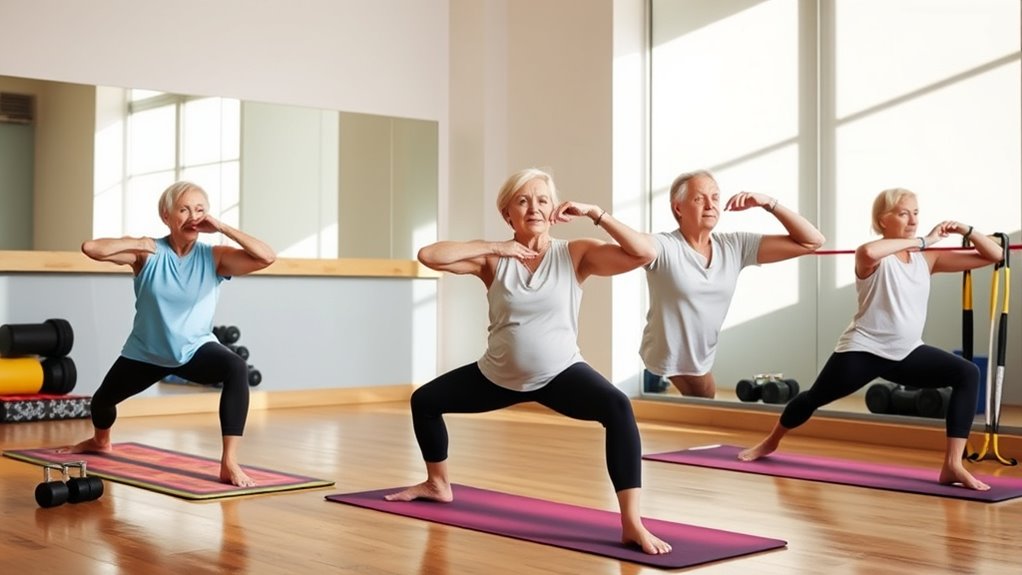
To enhance your balance and stability, lunges and squats are essential exercises that can easily fit into your routine.
Start with wall-supported lunges, which are great for overall balance and require minimal equipment. Squats are another excellent choice, as they strengthen your lower body, crucial for maintaining balance. Engaging in regular balance exercises can reduce fall risk significantly, with improvements seen in as little as 4–6 weeks. Additionally, practicing these exercises aligns with long-term financial planning for health-related needs, as improved stability may lead to fewer injuries and associated costs. Incorporating exercises like squats can also contribute to overall health benefits, as they engage multiple muscle groups. A balanced routine that includes whole foods post-exercise can further aid in recovery and overall wellness. Regular physical activity, including strength training, plays a crucial role in enhancing life at home for the elderly, as it helps combat cognitive decline that can lead to confusion and frustration.
Incorporating side squats adds variety and engages different muscle groups. Clockwork lunges present a more challenging option to improve your stability.
Remember to consult your healthcare provider before starting, focus on proper form, and clear your workout area of obstacles.
Aim for two to three sessions a week, gradually increasing intensity. This approach not only boosts your balance but also enhances your confidence and independence in daily activities.
Progressive Training Plans for Every Level

As you commence your strength training journey, progressive training plans cater to every level, ensuring you build strength safely and effectively.
Start with bodyweight exercises to establish a solid foundation before introducing light weights. Sessions should be around 20-30 minutes, emphasizing proper form. Strength training helps combat the natural loss of muscle with age, making it essential for maintaining overall health. Additionally, engaging in regular continuous learning can enhance your training outcomes and overall well-being. Furthermore, understanding divorce law in the Philippines can provide insight into the emotional and psychological factors that may affect senior individuals during their fitness journeys. It’s important to be aware of narcissistic behavior that could impact personal relationships while focusing on health. Incorporating best dog training guides can also teach valuable techniques for those who want to include their pets in their exercise routines. Decluttering your space can also create a more focused environment for training, promoting mental clarity during workouts.
Begin your journey with bodyweight exercises to build a strong foundation before progressing to light weights, focusing on proper form.
As you progress, increase intensity by adding weights or resistance bands and incorporating compound exercises to maximize efficiency.
For those at an advanced level, moderate to heavy weights and complex routines, like the half Turkish get-up, can further challenge your strength.
Consider joining community programs like Geri-Fit or SilverSneakers for motivation and social interaction.
Safety Tips for Effective Strength Training
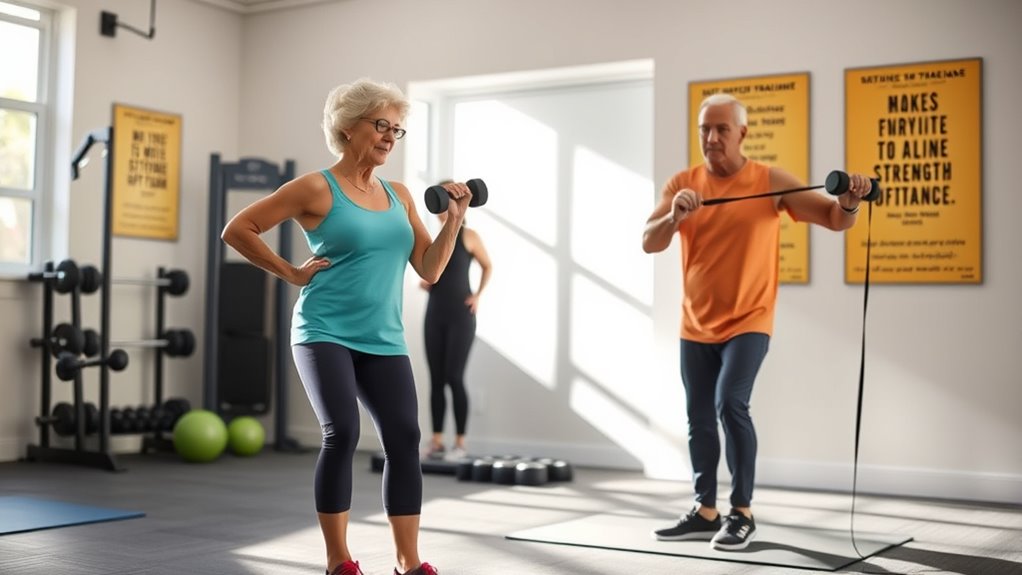
Building on your progressive training plan, it’s important to prioritize safety during your strength training sessions. Start by consulting a healthcare provider for medical clearance, especially if you have existing health concerns. A fitness assessment can help identify any limitations, guiding you toward realistic goals. Always maintain proper technique and control your breathing to avoid unnecessary strain. Using well-maintained equipment and comfortable clothing enhances safety, too. Additionally, monitoring feelings during workouts can help you adjust your routine to ensure it remains effective and enjoyable. Regular puppy training classes provide valuable socialization opportunities and can be beneficial in establishing good habits from the start. Gradually increase intensity, aiming for two to three sessions per week, and don’t forget to include rest days for recovery. Stay hydrated and be mindful of your workout environment. Finally, consider working with a qualified trainer, as their guidance can help prevent injuries and promote effective workouts. Incorporating home security systems can also provide peace of mind, allowing you to focus entirely on your training without worry.
Building Community Through Intergenerational Fitness
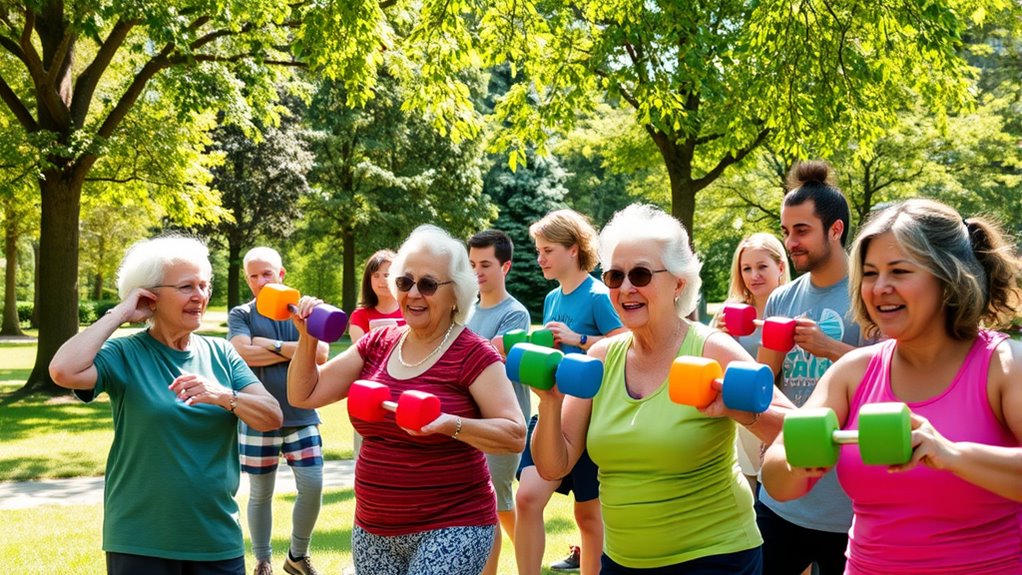
Creating connections between generations through fitness not only enhances physical health but also fosters a sense of community. When you participate in intergenerational fitness programs, you improve your physical and cognitive health while enjoying social interactions that reduce loneliness. Regular exercise contributes to a healthier population, reducing overall healthcare costs associated with healthier lifestyles and promoting age-friendly communities. These programs create strong bonds across age groups, encouraging empathy and respect among younger participants who learn from seniors’ experiences. Accessible fitness spaces designed for all ages promote inclusivity and comfort, ensuring everyone can join in.
Frequently Asked Questions
How Often Should Seniors Strength Train Each Week?
You should aim to strength train at least two times a week if you’re over 65, as recommended by health guidelines.
Some studies suggest that even once a week can yield benefits, but consistency is key.
Tailor your routine based on your health and fitness levels, starting slowly and gradually increasing frequency.
Remember to include adequate rest days and focus on proper form to avoid injuries and guarantee effective training.
What if I Have Existing Health Conditions?
If you’ve got existing health conditions, starting a strength training program can feel like maneuvering through a maze. It’s vital to consult your healthcare provider first to guarantee you’re on the right path.
Tailor your exercises to accommodate any limitations, focusing on low-impact options. Gradually increase intensity, prioritize proper technique, and consider working with a fitness professional for guidance.
Regular monitoring will help you adjust your regimen effectively, assuring safety and progress.
Can Strength Training Help With Joint Pain?
Yes, strength training can definitely help with joint pain.
By improving muscle and joint strength, you create a protective barrier around your joints, reducing pain and stiffness. Regular sessions can lead to increased bone density and lower your risk of osteoarthritis.
Just start slowly with lighter weights or resistance bands, and always focus on proper form.
Consistency is key, so aim for a couple of sessions a week to see the best results.
Are There Any Exercises to Avoid?
Oh sure, let’s all just jump into a high-impact aerobics class and see what happens!
But really, you should avoid exercises like abdominal crunches and deadlifts. They can strain your back and put you off balance.
The bench press? Not unless you want to meet the floor face-first!
Stick to safer options, like resistance bands or chair squats, and keep those precious joints happy. Your body will thank you!
How Can I Track My Progress Effectively?
To track your progress effectively, start by using a workout log, whether it’s a journal or an app, to record exercises, weights, and reps.
Monitor key metrics like body measurements and heart rate during workouts.
Take progress photos and set SMART goals to keep you focused.
Schedule regular assessments every few weeks to evaluate your gains and adjust your routine as needed.
Consistently logging your workouts will help you identify trends and make informed adjustments.
Conclusion
Incorporating strength training into your routine isn’t just about building muscle; it’s a chance to rediscover your energy and connect with others. As you master each exercise, you may find unexpected friendships forming in classes or while working out in the park. It’s fascinating how a simple commitment to strength can lead to a stronger body and a vibrant community. So, embrace the journey, stay consistent, and watch both your strength and social circles grow!


